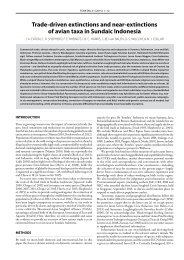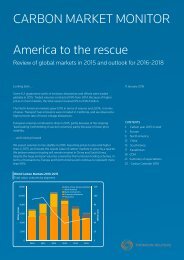Emissions Trading Worldwide
1TbjEHd
1TbjEHd
You also want an ePaper? Increase the reach of your titles
YUMPU automatically turns print PDFs into web optimized ePapers that Google loves.
Kazakhstan <strong>Emissions</strong> <strong>Trading</strong> System (KAZ ETS)<br />
in force<br />
emissions coverage (Mtco 2 e, 2015)<br />
Liable entities<br />
153.0<br />
166<br />
Gas coverage<br />
allocation<br />
Offsets & Credits<br />
co2 only<br />
free allocation<br />
domestic offsets<br />
Kazakhstan launched an ETS in January 2013. In January 2015, it<br />
entered the third phase of operation (2016–2020). The groundwork<br />
for the development of an ETS was laid out in 2011 through<br />
amendments and additions to Kazakhstan’s environmental legislation.<br />
Kazakhstan is currently working on improving these underlying<br />
laws.<br />
background information<br />
Phases and Allocation<br />
<strong>Trading</strong> periods Phase one (Pilot phase): 2013 Phase two: 2014–2015<br />
Phase three: 2016–2020<br />
Allocation Phase one (2013): 100% free allocation based on emissions<br />
data from 2010. Phase two (2014–2015): Free allocation (0% and 1.5% below<br />
2011/2012 average emissions). Phase three (2016–2020): Free allocation<br />
based on grandfathering.<br />
Compliance period One year<br />
Overall Ghg <strong>Emissions</strong> (excl. LULUCF): 284.3 MtCO 2 e (2012)<br />
OVERALL GHG EMISSIONS BY SECTOR<br />
MtCO 2 e<br />
Flexibility<br />
5.9 %<br />
7.6% 1.7 % 75.6 %<br />
9.2 %<br />
Industrial processes (16.7)<br />
agriculture (21.5)<br />
waste (4.9)<br />
Energy (excl. transport) (215.0)<br />
Transport (26.2)<br />
Banking and borrowing Banking and borrowing are not provided by current<br />
legislation. Offsets and Credits Qualitative Limit: The system allows<br />
domestic offsets. International credits may be allowed in the future.<br />
PRICE MANAGEMENT PROVISIONS Current legislation does not contain any carbon<br />
price control measures.<br />
GHG Reduction Targets BY 2020: 15% reduction from 1990 GHG levels.<br />
By 2030: 15–25% reduction from 1990 GHG levels (INDC Submission).<br />
ets size<br />
Cap Phase one (2013): 147 MtCO 2 (plus a reserve of 20.6 MtCO 2). This equals<br />
a stabilization of the capped entities’ emissions at 2010 levels. Phase two<br />
(2014–2015): 2014: 155.4 MtCO 2; 2015: 153.0 MtCO 2. This represents reduction<br />
targets of 0% and 1.5% respectively, compared to the average CO 2 emissions<br />
of capped entities in 2011–2012. Phase three (2016–2020): 746.5 MtCO 2 (plus a<br />
reserve of 21.9 MtCO 2).<br />
emissions coverage<br />
compliance<br />
MRV Reporting is required for businesses or financial facilities above the<br />
20,000 tCO 2/year threshold. Aside from CO 2, reporting is also required for CH 4,<br />
N 2 O and PFCs emissions. Reporting Frequency: annually, with reporting<br />
due on 1 April. Verification: Emission data reports and their underlying data<br />
require accredited third-party verification. Other: Installations below the<br />
compliance threshold must submit non-verified inventory reports.<br />
Enforcement In 2013, penalties for non-compliance were waived. The current<br />
non-compliance penalty is approximately EUR 30/tCO 2.<br />
other information<br />
Institutions involved Ministry of Energy, JSC Zhasyl Damu<br />
covered<br />
49–50 %<br />
not covered<br />
50–51 %<br />
GHG Covered CO 2<br />
Sectors & THRESHOLDS Energy sector (including oil and gas), mining and<br />
chemical industry (>20,000tCO 2/year). Inclusion Thresholds: For Phase<br />
one (2013) and Phase two (2014–2015), thresholds are based on 2010 and 2012<br />
emission levels. For Phase three, 2014 emission levels are used.<br />
Point of regulation Downstream<br />
Number of liable entities Phase three (2016–2020): 140 companies<br />
international carbon action partnership<br />
35




